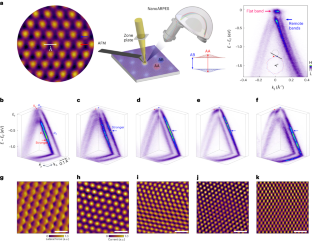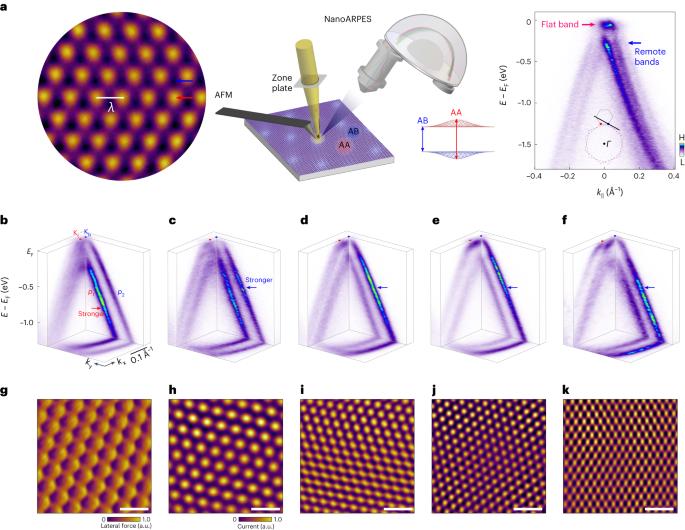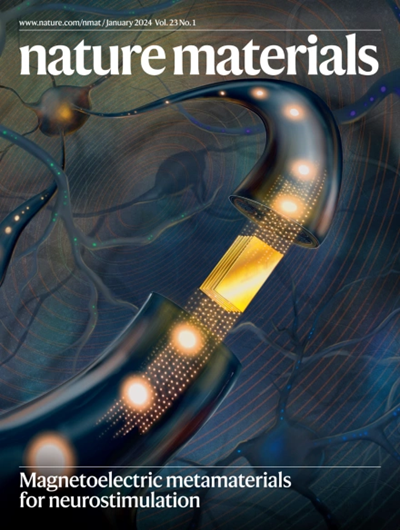Evolution of the flat band and the role of lattice relaxations in twisted bilayer graphene
IF 38.5
1区 材料科学
Q1 CHEMISTRY, PHYSICAL
引用次数: 0
Abstract
Magic-angle twisted bilayer graphene exhibits correlated phenomena such as superconductivity and Mott insulating states related to the weakly dispersing flat band near the Fermi energy. Such a flat band is expected to be sensitive to both the moiré period and lattice relaxations. Thus, clarifying the evolution of the electronic structure with the twist angle is critical for understanding the physics of magic-angle twisted bilayer graphene. Here we combine nano-spot angle-resolved photoemission spectroscopy and atomic force microscopy to resolve the fine electronic structure of the flat band and remote bands, as well as their evolution with twist angle from 1.07° to 2.60°. Near the magic angle, the dispersion is characterized by a flat band near the Fermi energy with a strongly reduced band width. Moreover, we observe a spectral weight transfer between remote bands at higher binding energy, which allows to extract the modulated interlayer spacing near the magic angle. Our work provides direct spectroscopic information on flat band physics and highlights the important role of lattice relaxations. By combining nano-spot angle-resolved photoemission spectroscopy and atomic force microscopy, the authors resolve the fine electronic structure of the flat band and remote bands of twisted bilayer graphene as the twist angle varies, revealing a spectral weight transfer between remote bands that is attributed to lattice relaxations.


扭曲双层石墨烯中平带的演变和晶格弛豫的作用
魔角扭曲双层石墨烯表现出相关现象,如超导性和莫特绝缘态,这些现象与费米能附近的弱分散平带有关。这种平坦带预计对摩尔周期和晶格弛豫都很敏感。因此,弄清电子结构随扭曲角度的演变对于理解魔幻角度扭曲双层石墨烯的物理特性至关重要。在这里,我们结合纳米点角度分辨光发射光谱和原子力显微镜,解析了平带和远带的精细电子结构,以及它们随扭转角从 1.07° 到 2.60° 的演变。在魔术角附近,色散的特征是费米能附近的平带,带宽大大减小。此外,我们还观察到在较高的结合能下,远程带之间的光谱权重转移,这使得我们可以提取出魔幻角附近的调制层间距。我们的工作提供了有关平带物理的直接光谱信息,并突出了晶格弛豫的重要作用。
本文章由计算机程序翻译,如有差异,请以英文原文为准。
求助全文
约1分钟内获得全文
求助全文
来源期刊

Nature Materials
工程技术-材料科学:综合
CiteScore
62.20
自引率
0.70%
发文量
221
审稿时长
3.2 months
期刊介绍:
Nature Materials is a monthly multi-disciplinary journal aimed at bringing together cutting-edge research across the entire spectrum of materials science and engineering. It covers all applied and fundamental aspects of the synthesis/processing, structure/composition, properties, and performance of materials. The journal recognizes that materials research has an increasing impact on classical disciplines such as physics, chemistry, and biology.
Additionally, Nature Materials provides a forum for the development of a common identity among materials scientists and encourages interdisciplinary collaboration. It takes an integrated and balanced approach to all areas of materials research, fostering the exchange of ideas between scientists involved in different disciplines.
Nature Materials is an invaluable resource for scientists in academia and industry who are active in discovering and developing materials and materials-related concepts. It offers engaging and informative papers of exceptional significance and quality, with the aim of influencing the development of society in the future.
 求助内容:
求助内容: 应助结果提醒方式:
应助结果提醒方式:


